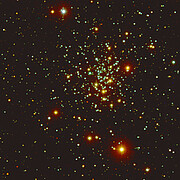Star Cluster with Surprising Similarities to Sun's Composition Offers Clues on Milky Way Evolution
3 Junio 2002, Albuquerque, NM
New observations of the richly populated star cluster NGC 2420 taken by the refurbished WIYN 0.9-meter telescope at Kitt Peak National Observatory suggest that the cluster contains a multitude of clues about the history and evolution of the Milky Way.
Gathered as part of a long-term project called the WIYN Open Cluster Study, the new photometric (brightness) data of NGC 2420 indicate that the cluster lies 35% farther from the center of the Milky Way than does the Sun. But in contrast to the Sun, which resides within the main disk of the Galaxy about 25,000 light-years from the center, this cluster lies about 3,000 light-years above the Galactic disk.
One surprising result being presented today in Albuquerque, NM, at the 200th meeting of the American Astronomical Society (AAS) is that the cluster's average composition seems to be very similar to the Sun's.
"It is unclear how a cluster that is as rich in chemical elements as the Sun is can have such a location and motion around the Galaxy," says lead author Emily Freeland of Indiana University, which is one of the major partners in the two Wisconsin-Indiana-Yale-NOAO (WIYN) telescopes on Kitt Peak. "Such clusters usually lie right in the Galactic disk."
One possibility is that NGC 2420 did form in the disk of the Milky Way, but then got kicked out by a close encounter with a massive object such as a giant molecular cloud. However, it is not readily apparent that such an encounter could throw NGC 2420 so far above the Galactic disk.
Another possibility is that NGC 2420 originally belonged to another small galaxy that was later absorbed by the Milky Way as our galaxy grew. "One problem with this idea is that small galaxies of this type are generally believed to be less rich in the chemical elements than the Sun," notes Constantine Deliyannis, a WIYN Open Cluster Study team member from Indiana University and Freeland's research advisor. "How could this little galaxy generate such a high abundance of heavy elements?"
The combination of NGC 2420's composition and its relatively rapid motion "remains puzzling," Deliyannis adds. "Solving this puzzle may ultimately yield clues about how our Milky Way Galaxy was put together and how it evolved."
The Open Cluster Study team determined the cluster to be roughly 1.7 billion years old, or about one-third of the age of the Sun. Although this is only 15% of the age of the Milky Way, most star clusters do not survive this long because they get torn apart by gravitational tidal forces from the Galactic disk.
NGC 2420 consists of approximately 1,000 stars packed into a roughly spherical volume of space just 30 light-years in diameter. Because all of the stars in a star cluster have similar ages and initial compositions, star clusters can be used as a laboratory to study many different areas of astronomy.
For example, stars of different initial masses evolve at different rates. The new data on NGC 2420 delineates stars in several distinct stages of life: a very clear main sequence (stars that are converting hydrogen into helium in their core, like the Sun); subgiant and giant branches (stars that have run out of core hydrogen); a red clump (giant stars converting helium into carbon in their cores); and, blue stragglers (somewhat mysterious stars which may represent a past merger of two stars into a single star).
There is also evidence for a significant population of binary stars in NGC 2420, with a surprisingly large fraction of these binaries being "twins" of roughly equal mass. "Other star clusters don't seem to have nearly as many twins," Deliyannis says. "This interesting result, together with studies of the general distribution of binary mass fractions, will teach us about the environments in which stars and star clusters form."
The new data on NGC 2420 contains very precise information about the surface temperatures of the stars that were observed, which is crucial for accurate interpretation of spectra of these same stars taken at the larger 3.5-meter WIYN telescope nearby on Kitt Peak.
"Together, data from both WIYN telescopes may ultimately reveal whether stellar rotation has caused the interior of these stars to mix over time and, if so, to what extent," Deliyannis says. "This distribution of internal composition has implications for understanding the chemical enrichment history of our Galaxy, and for testing Big Bang nucleosynthesis."
Other co-authors of display poster 9.01 in the Southwest Exhibit Hall of the AAS meeting are A. Steinhauer (Indiana University) and A. Sarajedini (University of Florida).
The WIYN consortium assumed operations of the historic 0.9-meter telescope on Kitt Peak in fall 2001 to enable it to serve as a complement to the existing 3.5-meter WIYN telescope on Kitt Peak, and to offer a facility for hands-on learning and research by students at the three partner universities.
For example, Freeland did this research as part of her undergraduate honors thesis and will remain associated with WIYN through pending graduate study in astronomy at the University of Wisconsin-Madison.
Notas
Located southwest of Tucson, AZ, Kitt Peak National Observatory is part of the National Optical Astronomy Observatory (NOAO), which is operated by the Association of Universities for Research in Astronomy (AURA), Inc., under a cooperative agreement with the National Science Foundation.
Enlaces
- More information about the transfer of the 0.9-meter telescope to the WIYN consortium
Contactos
Douglas Isbell
Public Information OfficerNational Optical Astronomy Observatory
Tel: 520/318-8214
Correo electrónico: disbell@noao.edu
About the Release
| Release No.: | noao0203 |
| Legacy ID: | NOAO 02-03 |
| Nombre: | NGC 2420 |
| Facility: | WIYN 0.9-meter Telescope |



